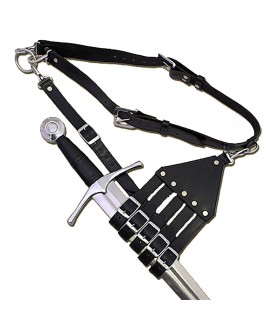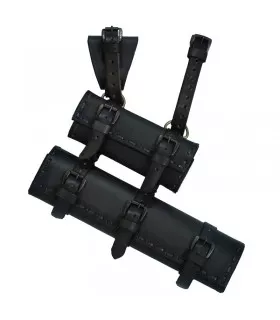What is a Baldric?
The baldric is a historical piece that stands out for its functionality and design, associated with the transport of weapons, particularly swords, during the 16th and 17th centuries. This accessory, beyond its utility in military equipment, represents a cultural element that combines practicality with aesthetics, even reflecting the social status of those who wore it.

What is a Baldric?
The baldric is an accessory designed to support and carry swords. It is defined as the structure from which the straps (bands or belts) hung, connecting the sword to the belt or girdle. In this way, this accessory fulfilled both support and accessibility functions, ensuring the weapon was ready to be used at any moment.
Function of the Baldric
Throughout history, the baldric played an essential role for soldiers, knights, and armed civilians. Its design allowed the sword to be carried comfortably, securely, and accessibly. This practicality translated into greater efficiency during confrontations or ceremonies, where the sword also held symbolic value.
How was the Baldric Made?
The making of the baldric was entrusted to harness makers or specialized artisans, ensuring high quality and precision. Metal elements such as buckles and hooks, essential for connecting the baldric to the girdle, were often produced by skilled swordsmiths. This division of labor ensured durable and functional products.

Materials Used
Baldric materials varied depending on the economic level and social position of the wearer. Among the most prominent materials are:
- Leather: Frequently used, varieties like cowhide, kidskin, or cordovan were employed.
- Velvet and silk: In more luxurious models, the leather could be lined with these fabrics, enhancing its aesthetic appeal.
- Sea wolfskin or suede: Less common but valued in decorative or exclusive pieces.
Decoration and Personalization
In addition to its practical function, baldrics were also a reflection of fashion and social status. Decoration played a significant role, which could include features such as:
- Gold stitching and braiding.
- Engravings in floral or geometric patterns.
- Gold- and silver-plated hardware.
- White studs, bluing, or striped effects.
These intricate decorations were a symbol of prestige, especially among military and civilian elites. In some cases, the straps and girdle associated with the baldric were also decorated to maintain design consistency.
Relationship with the Strap
It's common to find some confusion between the baldric and the strap. While the former was connected to the belt or girdle, the strap was a leather band that crossed the chest and hung from one shoulder, suspending the sword at the side. This suspension method, of Arabic origin, was sometimes used as an alternative to the baldric.
A Multifaceted Element
The baldric was not merely a functional accessory; its design and use transcended the practical, turning it into an indicator of social rank and the lifestyle of its era. Whether on the battlefield or in ceremonial occasions, the baldric was as useful as it was aesthetic.
| Characteristics | Description |
| Function | Support for swords, attaching them to the belt. |
| Materials | Leather, velvet, silk, among others. |
| Decorations | Stitching, metal braids, engravings, and studs. |
















